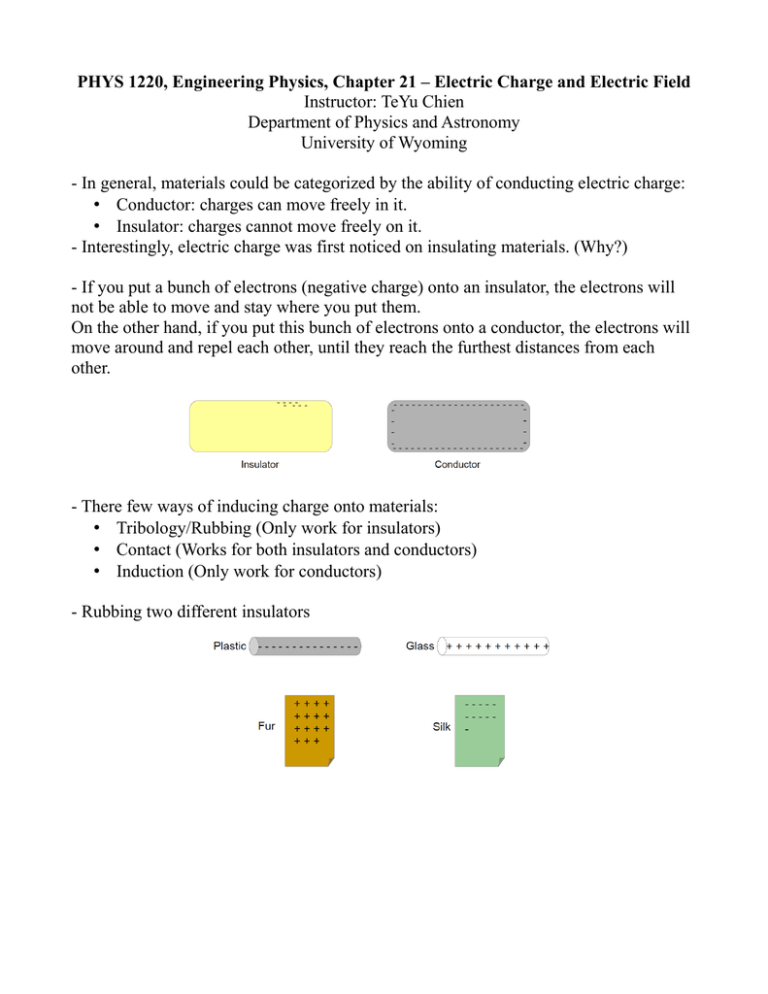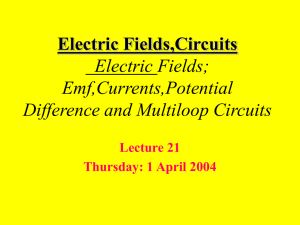PHYS 1220, Engineering Physics, Chapter 21 – Electric Charge and
advertisement

PHYS 1220, Engineering Physics, Chapter 21 – Electric Charge and Electric Field Instructor: TeYu Chien Department of Physics and Astronomy University of Wyoming - In general, materials could be categorized by the ability of conducting electric charge: • Conductor: charges can move freely in it. • Insulator: charges cannot move freely on it. - Interestingly, electric charge was first noticed on insulating materials. (Why?) - If you put a bunch of electrons (negative charge) onto an insulator, the electrons will not be able to move and stay where you put them. On the other hand, if you put this bunch of electrons onto a conductor, the electrons will move around and repel each other, until they reach the furthest distances from each other. - There few ways of inducing charge onto materials: • Tribology/Rubbing (Only work for insulators) • Contact (Works for both insulators and conductors) • Induction (Only work for conductors) - Rubbing two different insulators - Contact: - Induction: • Where are those charge comes from? (Look into atomic structure) - “Electron Transfer” between materials is the main mechanism for the charges. The lack of electron infers to “positive” charge, since atoms are neutral to begin with. - Electrons will not disappear, so, the amount of charges is a conserved number. • Electric Forces - Attraction forces between opposite signs of charges. - Electric Forces are larger when the separation between charges are closer. (What is the dependence on the distance?) • Coulomb's Law ⃗ =k F q1 q 2 r2 r̂ is the electric force; and q 2 are the amount of the charges of the two objects; is the distance between the two charged objects; is the unit vector representing the direction of the force is along the direction of the two objects. ⃗ F q1 r r̂ k= 1 =9.0×109 N⋅m2 /C 2 4 π ϵ0 Some useful constants: ϵ 0=8.854×10−12 C 2 / N⋅m2 electron charge: e=1.6×10−19 C • Electric Field The definition of the electric field “felt” by the charge, q2: ⃗ F ⃗ E= q2 ==> F⃗ =q 2 E⃗ - Why we need to use electric field when we already know the electric force? Mostly, just more convenient for many situations. We usually want to know when a charge put in a certain region with electric field, how that charge would respond. - So, the electric field “created” by a charge, q1, in the space could be written as: ⃗ E =k q1 r2 r̂ - Forces could be added, and same as the electric field. Considering the following situation, the total force acting on q0 could be computed by adding the two forces caused by -q and q, so does the electric field. ⃗ = F⃗ 1+ F⃗ 2=q 0 E⃗1+q0 E⃗2 F • - Visualizing the electric field: Electric Field Lines To know even better how these two charges, -q and q, building the electric field in the plane, you could either: (1) calculate the electric field point of interested when you need it; or (2) plot out the electric field lines to visualize it. • Electric Dipoles - An electric dipole is a pair of point charges with equal amount and opposite sign of charges, -q and q, separated by a distance d. - The electric dipole will align itself along the electric field. - How much is the torque, if it was not aligned in the first place? ⃗ ; F⃗1 =q E ⃗ F⃗ 2=−q E ⃗ = d ⋅∣F⃗1∣⋅sin (ϕ)+ d ⋅∣F⃗2∣⋅sin (ϕ)=qd ∣E ⃗∣sin (ϕ)=∣⃗p∣∣⃗ ⃗ ⃗τ =⃗r × F E∣sin (ϕ)= ⃗p× E 2 2 - Electric force is one type of Conservation Forces (What is “conservation force”? What are other types?), so the work done by the electric forces could be defined as “potential energy”: Δ U =−W ⃗ ⋅⃗s =∫ q∣⃗ W =F E∣⋅sin (ϕ)⋅d ∣⃗s∣+q∣⃗ E∣⋅sin (ϕ)⋅d ∣⃗s∣=∫ 2q∣⃗ E∣⋅sin (ϕ)⋅d ∣⃗s∣ d d d ∣⃗s∣= ⋅d ∣ϕ∣=− ⋅d ϕ 2 2 ϕ2 ⃗∣∫ sin(ϕ) d d ϕ=qd ∣⃗ ⃗∣cos (ϕ2 )+qd ∣⃗ W =−2q ∣E E∣(−cos (ϕ2 )−(−cos (ϕ1)))=qd ∣E E∣ cos( ϕ1 ) 2 ϕ W =∣⃗p∣∣⃗ E∣cos (ϕ2)−∣⃗p∣∣⃗ E∣ cos(ϕ2) Remember that: Δ U =−W 1 So, we can define the potential energy of a electric dipole in a electric field as: U =− ⃗p⋅⃗ E Math Preview for Chapter 22: • Vector inner product • Calculate volume in 3D • unit vector • Integral over a closed surface (conceptually) Question to think: • How to calculate electric field inside a charged conductor?




